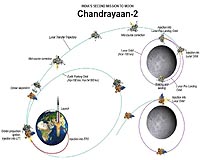 |
Paris, France (ESA) Nov 09, 2009 ESA's Education Office has awarded a contract to Surrey Satellite Technology Ltd of the UK to manage the development and testing of the first European student mission to the Moon. Launch is expected in 2013-2014. Surrey Satellite Technology Ltd (SSTL) has been selected as the prime contractor for the European Student Moon Orbiter (ESMO) project. The final signature of the contract took place on 4 November 2009. The mission involves delivering a spacecraft to lunar orbit, followed by 6 months of operations that include mapping of the lunar surface and studying our nearest neighbour. Unlike a typical space project, each spacecraft subsystem, payload and ground segment element is being designed, built and operated by groups of university students based in ESA Member States or Cooperating States. As with the previous satellites sponsored by the ESA Education Office, the objective of ESMO is to prepare the next generation of European engineers and scientists by providing valuable hands-on experience with a real and demanding space project. The feasibility study and preliminary stages of spacecraft and payload design were led by the Education Office and have involved teams of interested students. More than 200 university students from many different countries and institutions have already participated in these early phases of the project. Opening workshop Once the initial decision was made to appoint SSTL as the system prime contractor, a workshop was held at the company's premises in Guildford, UK, 6-8 October. Representatives of 19 European universities attended this important milestone for the project. Each university team, represented by a professor and one student, summarised its role in ESMO, including a technical overview of the team's subsystems and their future work plan. The resources required for completing the work were also discussed. SSTL explained its approach to low-cost space systems engineering and its plan for ESMO's development phases. The company will oversee ESMO's technical development, drawing on its extensive experience in delivering cost-effective space missions to customers and its knowledge-transfer programmes. Next steps The next major milestone for ESMO will be the System Requirements Review in early 2010, when the universities selected to participate in the final phases of the project will be announced. The system requirements and system design will then be finalised and the specific development role of each university will be confirmed. Through contractual relationships with the universities, academic staff will become an integral part of the development process, ensuring continuity as students come and go, as well as providing greater assurance for delivering a good final product. ESMO is the fourth small satellite mission within ESA's Education Satellite Programme. It is expected to be launched as a secondary payload in late 2013 or early 2014. Share This Article With Planet Earth
Related Links European Student Moon Orbiter (ESMO) project Mars News and Information at MarsDaily.com Lunar Dreams and more
 Chandrayaan-II Mission Over By 2012-13
Chandrayaan-II Mission Over By 2012-13Bangalore, India (PTI) Nov 09, 2009 Chandrayaan-II moon mission, which will help in analysis of mineral composition and undertake terrain mapping of the moon, will be completed by 2012-13, Project Director of Chandrayaan Dr M Annadurai has said. "The Rs 425 crore project will be completed by 2012-13. As opposed to Chandrayaan-1 which was a moon orbiter, in Chandrayaan-2, the two moon rovers will actually land on the moon ... read more |
|
| The content herein, unless otherwise known to be public domain, are Copyright 1995-2009 - SpaceDaily. AFP and UPI Wire Stories are copyright Agence France-Presse and United Press International. ESA Portal Reports are copyright European Space Agency. All NASA sourced material is public domain. Additional copyrights may apply in whole or part to other bona fide parties. Advertising does not imply endorsement,agreement or approval of any opinions, statements or information provided by SpaceDaily on any Web page published or hosted by SpaceDaily. Privacy Statement |